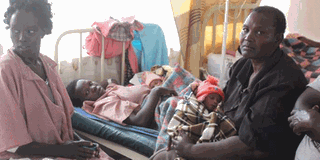Most hospitals are ill-equipped: Report

Mothers at Mercy Missionary Hospital in Eldama Ravine on December 15, 2016 wait to be attended to. Many hospitals lack crucial drugs to save mothers' lives. PHOTO | CHEBOITE KIGEN | NATION MEDIA GROUP
What you need to know:
- Other crucial drugs missing include magnesium sulphate, used for preventing fatal convulsions in mothers with blood pressure during pregnancy, known as eclampsia.
- Health facilities in western region led at a shocking 54 per cent, followed closely by Nairobi (44 per cent) and Rift Valley (39 per cent).
Nearly nine in 10 hospitals — 86 per cent — in Kenya don’t have life-saving maternal and child health kits such as oxytocin, used to stop bleeding during delivery, a national survey shows.
Other crucial drugs missing include magnesium sulphate, used for preventing fatal convulsions in mothers with blood pressure during pregnancy, known as eclampsia.
The World Health Organization lists 17 essential drugs required in health facilities to conduct safe deliveries and care for mothers and take care of infants.
These drugs are clustered in five groups and a hospital should have at least one in each cluster and an additional mandatory two of oxytocin and magnesium sulphate.
These medicines include antibiotics, which could be mild to stronger second-line ones used after caesarean section to prevent sepsis and other life-threatening infections that kill many women in Sub-Saharan Africa.
The 2015 Kenya Health Facility Assessment launched Thursday in Nairobi sampled 641 hospitals in Kenya to investigate the availability of family planning and reproductive health services.
Surprisingly, 38 per cent of all facilities did not have any of the seven.
Health facilities in western region led at a shocking 54 per cent, followed closely by Nairobi (44 per cent) and Rift Valley (39 per cent).
Sadly, government hospitals (79 per cent) were the worst hit with month-long or more delays since they receive their supplies from central medical stores.
FINDINGS
The ease at which women are able to access the medicines is an indicator of maternal and child health as well as on the country’s ability to exploit its population for development, collectively called “demographic dividend”.
Ms Anne Lindeberg, technical specialist of the United Nations Population Fund which funded the survey, said that while Kenya has made progress in maternal and child health, there was a need to invest more in reproductive health to save lives.
The 2014 Kenya Demographic Health Survey indicates that Kenya’s maternal mortality in 2014 was 362 deaths per 100,000 live births, a slight improvement from 520 in the 2008/2009 report.
While mission run and private facilities replenish their stock at intervals every one or three months, government run hospitals supplied once every six months.
Reasons cited by the study include:
1. The supply chain was riddled with delays with 47 per cent of hospitals having to wait for two weeks to receive their orders and 32 per cent a month.
2. More than a third (32 per cent) of facilities receive supplies from central medical stores, regional stores (30 per cent) and private suppliers (27 per cent).





